The Healthiest Thai Foods and Takeout Options, According to a Nutritionist
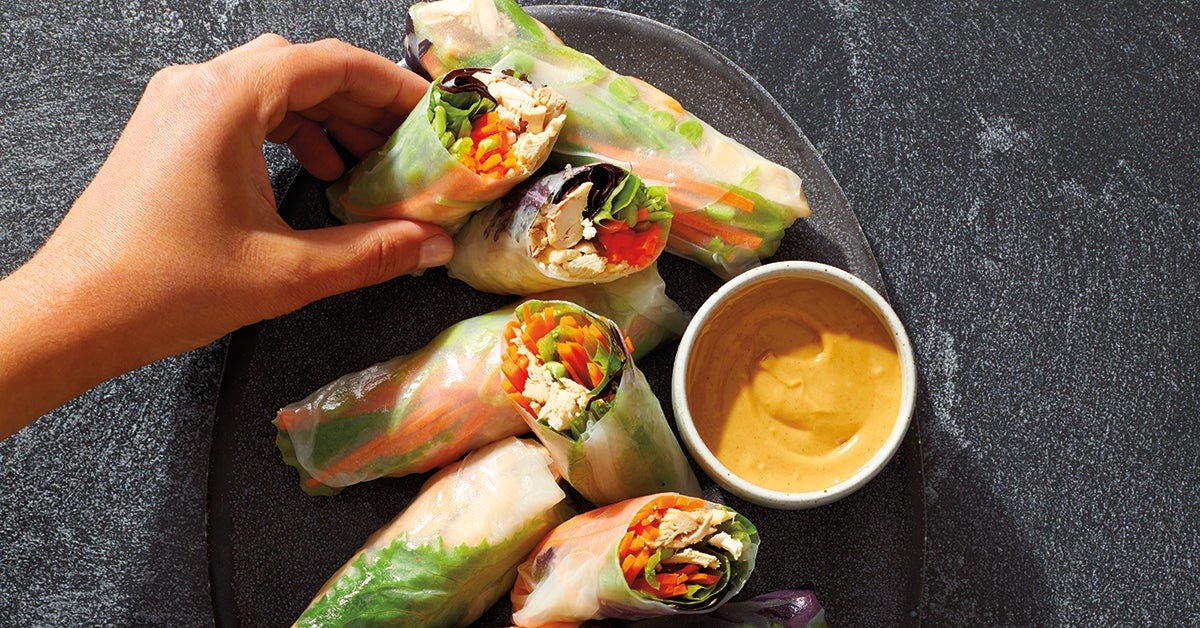
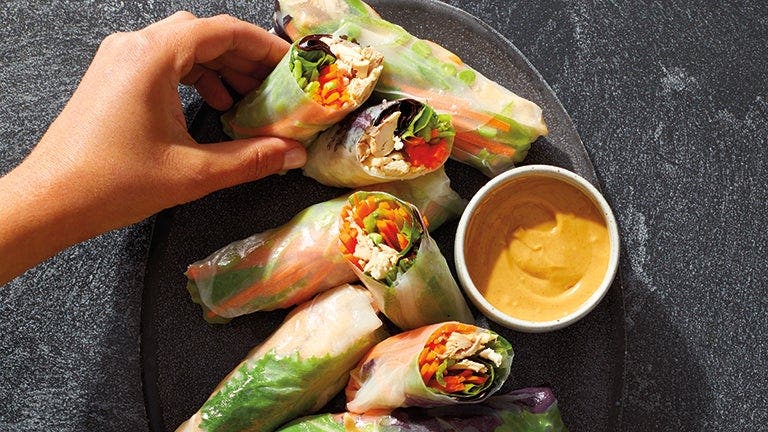
Thai food menus are filled with veggies, lean proteins, and lots of flavor. “In almost every dish, you'll find sweet, sour, salty and spicy flavors coming together,” says Chef David Bank, a native of Thailand who owns the Land Thai and PURE Thai Shop House restaurants in New York City. With so many delicious options, Thai food provides an opportunity to lean into your ZeroPoint foods without sacrificing on flavor. Use these simple ordering tips to dish up a healthy Thai meal that’s a hit for your taste buds.
7 Strategies for Staying on Track
Go with lean protein
Thai menus often offer the same dish with a choice of meats and proteins, but not all are equal. Pick skinless chicken breast for a protein boost without a lot of saturated fat. Thai cuisine also presents the perfect opportunity to enjoy a vegetarian meal (toss in some tofu if you’d like). With so many bold flavors, chances are you won’t even miss the meat.
Hold the nuts
A sprinkling of nuts is fine, but peanut sauce delivers a concentration of calories and fat, with at least 2 PersonalPoints value per tablespoon. Ask for a side of hot chili sauce instead. It will add big flavor at little to no caloric cost.
Be a heat-seeker
As the heat increases, you will generally cut back on portions, because the flavors are more intense.
Choose rice wisely
Rice is the foundation of Thai cuisine. “In Thailand, Jasmine rice is quite expensive, and would only be served in a very fine restaurant, but in the U.S., it is the most characteristic rice of any Thai dish,” says Bank. You’ll also find plain white rice, which Bank often prefers as a sort of ‘neutral canvas’ to temper spicy dishes. Brown rice, however, is becoming increasingly popular in Thai cuisine. Like white rice, it has 6 PersonalPoints value per cup, but it has three times the fiber as white rice, supporting heart and digestive health and helping you feel fuller, says Angela Goscilo, MS, RD, CDN, WeightWatchers®’ senior manager of nutrition. It may even be on your ZeroPoint foods list!
Go for nutrient-dense apps
Some of the healthiest dishes of Thai cuisine are soups and salads. They’re also the perfect meal starter. A broth-based soup with veggies or seafood will help to fill you up without spending a lot of Points, says Goscilo. Sharing apps with the table? “Opt for chicken satay or spring rolls which will give you a little protein to get started,” adds Goscilo.
Know your coconuts
Coconut, whether it’s flakes, milk or cream, can make a cameo at any course in Thai cuisine. The flavor is delicious, but you are adding extra calories and saturated fat to the meal. If that signature coconut flavor is a must, choose coconut milk over cream, and flaked coconut over milk.
Eat what you love
Yes, going out to eat may have a bigger impact on your Points budget than cooking from home. But, going out or ordering takeout gives you an opportunity to eat something you wouldn't make in your own kitchen or try a new dish. “Scan the menu and choose what you really want,” says Goscilo. “At the end of the day, food is meant to be enjoyed."
How to Make Your Thai Favorites Even Healthier
The great news about classic Thai menu items? There’s not a boring bite in the bunch. Even the healthiest options pack lots of flavor, and with a little sound advice you can lighten up the more decadent dishes. The below Thai favorites can be found in most places, from white tablecloth restaurants to street carts.
Appetizers | |
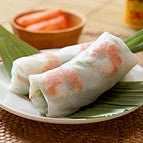 | Thai Spring Roll (Po Pia Tod) These apps are made by filling a rice paper wrapper with mushrooms, bean sprouts and shrimp (pork and chicken versions are also available). Sounds great — but then they hit the fryer to become a crispy, golden brown Thai version of an eggroll, with 6 PersonalPoints value each. Lighten it up: Try Vietnamese-inspired spring rolls (Po Pia Sot), which forgo the frying. At about 80 calories each, they offer the same great fillings, with a PersonalPoints value of only 2. |
 | Satay Skewers Beef or chicken chunks are marinated overnight with turmeric, a little palm sugar, salt, coconut milk and bay leaf. The downfall is that after grilling, they're traditionally served smothered with peanut sauce, so two skewers can run 12 PersonalPoints value. Lighten it up: Unsauced, two skewers drop to 3 PersonalPoints value for beef and only 2 PersonalPoints value for chicken. Get the sauce on the side and enjoy a taste, adding 1 PersonalPoints value for each tablespoon used. |
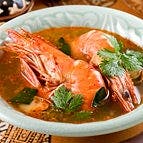 | Hot and Sour Soup (Tom Yum Goong) This spicy, sour soup has many variations across Thailand and neighboring countries. The combination of prawns, chilis, and kaffir lime is a healthful choice, with one cup offering just 2 PersonalPoints value. (FYI: The fish paste used for flavoring can impart a lot of sodium.) Lighten it up: This soup is a good option, but be wary of modern variations like Tom yam namkhon, which add heavy coconut milk. |
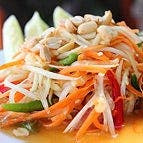 | Green Papaya Salad (Som Tam Thai) This salad is prepared by crushing the papaya with a mortar and pestle, while adding flavorful ingredients like garlic, spicy chilis, lime juice, and palm sugar. Peanuts deliver crunch; fish sauce makes it savory and salty. The result: All the classic flavors of Thai cuisine, with 4 grams of fiber for only 3 PersonalPoints value. Lighten it up: Green Papaya salad is often served with a side of sticky rice or noodles. Unless you're having it as a meal, pass on the rice to avoid adding 6 PersonalPoints value. |
Main Entrees | |
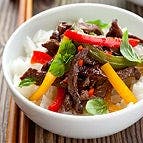 | Stir Fry Beef with Thai Basil (Pad Kra Pow) With the distinct licorice flavor of Thai basil, a shot of oyster sauce, plenty of garlic, and Thai chilis, this dish delivers big flavor. A restaurant version is typically heavy on the beef, with about 5 oz. of beef and 3 oz. of vegetables, meaning you could be looking at 21 PersonalPoints value or more — before adding rice. Lighten it up: As with any stir-fry, ask the kitchen to go easy on the oil. Each Tbsp. spared saves 4 PersonalPoints value. Request extra vegetables to replace some of the beef. |
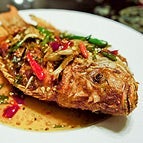 | Fried Whole Fish with Chili and Tamarind Sauce (Pla Rad Prig) In the U.S. this dish is typically made using a whole red snapper or Barramundi, which is flavored with a mix of tart tamarind paste, sweet palm sugar and spicy chilis before being deep fried. Nutritionally speaking, “fried” says it all. With a whole fish of about 1 1/4 pounds, you’ll get two filets with 37 g of protein, but the frying fat will up the tally to 30 PersonalPoints value. Lighten it up: Request that your fish be sautéed or, ideally, steamed. A single satisfying steamed filet, served with rice and vegetables, will be closer to 12 PersonalPoints value. |
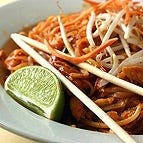 | Pad Thai For many, this noodle dish is the gateway to Thai cuisine. With rice noodles coated with oil, firm egg and a topping of crunchy peanut, it’s a delicious treat. But American portions make it a belly-buster. “In Thailand this is a few bites, but here it is a main course, and often gets lots of additions, like chicken,” says Bank. Even optimistic counts put a 10 oz. restaurant portion with chicken at nearly 40 SmartPoints value. Lighten it up: Avoid the super-sized portion by saving half the order for another meal. |
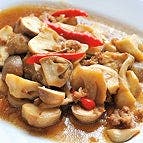 | Massaman Curry This is one of the richest dishes available, with coconut milk and coconut cream adding saturated fats. And it often has calorie-intense meats, like fatty beef, duck, or dark-meat chicken. Just a single-cup portion with beef will contain 35-36 PersonalPoints value, and you could well be served two cups per order. Lighten it up: Request skinless chicken breast instead of beef, duck or dark-meat chicken, and add a side order of vegetables to help fill you up without adding more Points. |
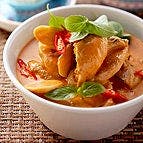 | Red Curry If you’re in the mood for curry, red curry with vegetables is one of the better choices. This curry usually has coconut milk, but not cream. Lighten it up: Choose vegetables or chicken over beef and try this: Eat it with a fork, not a spoon, so you are enjoying the flavor but not slurping up every drop of fat. With these tips, you can enjoy a one-cup portion for about 11 PersonalPoints value. |
Sides | |
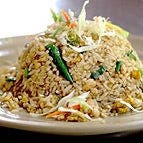 | Thai Fried Rice (Khao Phat) Thai fried rice comes bursting with the flavors of Thailand, most notably aromatic Jasmine rice. A typical two-cup restaurant portion will be about 22 PersonalPoints value, but adding flavorings like sausage or coconut will up the ante. Lighten it up: Ask for extra vegetables to displace some of the rice. Replace a half cup of white rice and you’ll trim about 3 PersonalPoints value. |
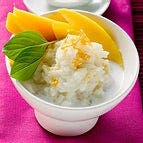 | Sweet, Sticky Coconut Rice with Mango A 1 1/2 cup serving of this classic dessert, which is like coconut rice pudding topped with fresh mango, will tally up to 14 PersonalPoints value. Lighten it up: “Thai desserts are made with sticky rice, a highly glutinous rice that will fill you up in five bites, so this is a satisfying dessert for splitting among the table,” says Bank. Or, go for nothing but the mango, which is free — at least in terms of PersonalPoints value. |
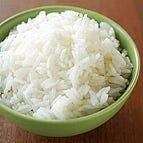 | Jasmine Rice Similar to white rice, this Thai variety is slightly sweeter and is frequently prepared with a light touch of spices. One half-cup serving contains about 3 PersonalPoints value. Lighten it up: You can spare a couple of Points in your budget for dessert by using it as a seasoning to your entree. Instead of using it as a bed under your meal, sprinkle a couple of tablespoons over your meal. |
Desserts and Drinks | |
 | Fried Banana (Kluay Kaek) Sliced baby bananas, braised in coconut milk and deep-fried, are a popular Thai restaurant pick. Bananas offer good nutrition with 0-3 PersonalPoints value, but this dessert comes with a high price, easily reaching 6 PersonalPoints value (or more). Lighten it up: Go for fresh, sweet, ripe bananas drizzled with a little coconut milk for just 1-4 PersonalPoints value. |
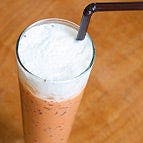 | Thai Iced Tea Made with brewed tea that has been sweetened with condensed milk, or sometimes coconut milk, an 8-ounce glass of Thai iced tea can add 8 PersonalPoints value to your meal. Lighten it up: If you really want to enjoy this traditional beverage, order just one, then drink water for the rest of your meal. |
*Given that ingredients, cooking methods, and portions sizes can vary greatly among restaurants, all PersonalPoints values for restaurant dishes are estimates.
